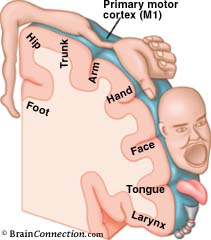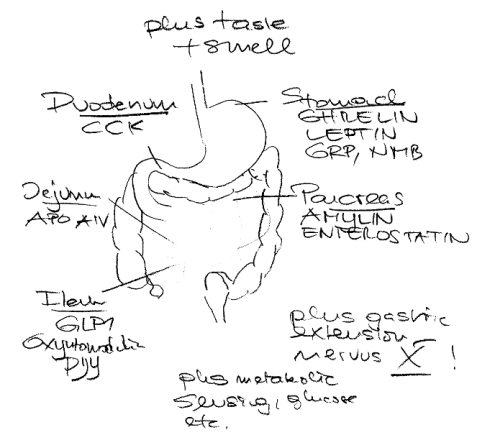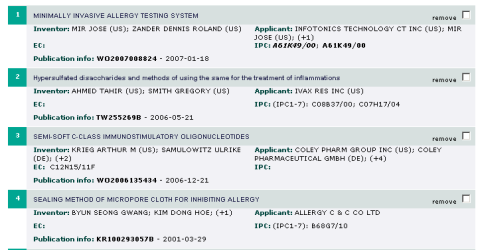Yesterday I heard for the first time of this psychology term. It describes how humans cope with stress, anger or other negative events – even over long time periods. Some people give up but others still grow (“skipjacks”). Seems that this trait can be immedately tested in scientists ;-) there is even a journal Disaster.
Supersize me II
Some of you may remember the fake food hypothesis that relates the obesity epidemic to the introduction of highly processed industrial food. JCI now has a nice review on the satiation signal and the complex system that may be disturbed.
Microbe content might also be important in this context click | click | click, however, even the adoptive transfer might be a secondary effect – everything in biochemistry follows mass equilibrium constants. The poorer resorption in the lean may lead to a different colonialization and vice versa. Will the adoptive transfer really show lasting effects longer than 2 weeks (in the mouse study)? Isn´t colonialization not influenced by diet (in the human study)?
Yea, yea.
XP system crash
I had to manage a system crash this weekend – where even the rescue console did not work. I learned that (1) my old Knoppix CD could neither write to the hard disk nor (2) read access a truecrypt partition. (3) Too late, I should have spent some money on ghost(r) or true image(r)! I further learned on the next day that (4) Bart PE does not work with OEM versions, (5) truecrypt versions are not compatible and (6) a grml iso is not helpful at the system prompt. Ultimately I came across (7) sysresccd that includes
- GParted: partition resize tool
- GNU Parted: a text tool for editing disk partitions
- Partimage: a partition image tool
- Plenty file systems tools allow you to format, resize, and debug an existing partition of your hard disk
- Ntfs3g allows you to mount your partition and get a full read/write access to the NTFS partition
- Sfdisk allows you to backup and restore your partition table
wow, simply a lifesaver.
Allergy and DC antigen processing: vitamin versus hygiene hypothesis
Last week Science has an update on differential antigen processing by DCs including a key sentence on immature DCs:
Cultured immature DCs capture antigen but only process and present it on MHC II after exposure to inflammatory stimuli or TLR ligation.
Although the authors were not aware of current allergy research, they perfectly summarize how vitamin D renders DC immature, while hygiene (infections or LPS farm exposure ) may antagonize it.
Enter without knocking if you can
This was posted at the door of Max Delbrück (1906-2006) in Pasadena – and quoted from the wonderful biography of E.P. Fischer his last Ph.D. student.
/-/
“Licht und Leben” (or “light and life”) is a wonderful narrative that I really enjoyed, with a lot of informative figures and tables.
I wonder why this biography never appeared in English, why neither institutes in Berlin, Cologne or Constance (where Delbrück teached) are even linking to it. E.P. Fischers book tells the story about an interesting man dedicated to science – who learned physics and applied sound principles to biology. “Enter without knocking” does not have any special meaning (as E.P. Fischer confirmed me) it was simply a rough-running door. Besides the biographical sketch and the detailed description of phages and phycomyces (p15) there are many moments in time that I really liked very much.
/-/
Hershey (with whom he shared the Nobel in 1969) should give a lecture and asked about the background of the audience. Max Delbrück answered by a postcard 6/1/1943: think of “complete ignorance and infinite intelligence” – the lecture became a success.
/-/
Delbrück always emphasized (p 148) that data should only be augmented by those who can put old data into new hypotheses. He even said “enough data” as thinking about current experiments is being as important as doing new ones. Both, thinking and doing experiments, should even be more important than publishing (his lifetime list has 115 items). Writing up results should serve as a method to connect what is currently known and what will be known. Delbrück even suggested to spend – “one day per week without pipettes”.
/-/
From an interview (p 240): “Genetic engeneering may possibly be a large thread for the future but possible also the biggest hope”.
/-/
Delbrück was a great admirer of Eliot, Rilke and of Beckett. Samuel Beckett in “Waiting for Godot” probably inspired “Licht und Leben” (p 260): “We give birth astride a grave, the light gleams an instant, then there is night once more.”
Addendum
Page 239 contains a mystery: In 1978 Delbrück gave a lecture at Caltech where he wanted to include a citation from Kierkegaard: “Wissen ist eine Sache der Einstellung, eine Leidenschaft, eigentlich eine unerlaubte Einstellung. Denn der Zwang zum Wissen ist wie Trunksucht, wie Liebesverlangen, wie Mordlust, in dem sie einen Charakter aus dem Gleichgewicht wirft. Es stimmt doch gar nicht, daß der Wissenschaftler hinter der Wahrheit her ist. Sie ist hinter ihm her. Er leidet unter ihr.” Delbrück, however, could not find the correct source, even announced to pay 50$ for it. I also looked at my library but couldn´t locate it – who knows the source?
Science of course and effective too
Most people in the field search Pubmed but there is another site that I frequently visit – the European patent database that often have more concise information. Look at current allergy patents – the last one will definitely work you may also use a big plastic bag ;-)
Be aware that being cynical is probably bad for your heart.
Badges everywhere
My favorite is the pink one that a sick child made me earlier in my career.
Le Grand Content
Attending several large conferences every year, I know what Andre at Youtube is talking about:
This has even a name – Powerpoint Karaoke, yea, yea.
Craving comes from the insula
You may renember the homunculus – a projection of body functions on brain areas. There is an interesting clinical extension stemming from 69 stroke patients of which 15 immediately, easily and permanently quit smoking. One patient said that his “body forgot the urge to smoke”. Sure, this analysis may still be somewhat confounded by the fact that certainly more areas are usually destroyed – but there are interesting approaches that could be followed up, the authors speculate about influencing sensory airway representation, neurotransmitter therapy and monitoring of smoking cessation programs. So stroke may help to quit smoking but I think there are better ways to do that. Seems that Science won this race with Nature. Yea, yea.
Addendum
Don’t miss the follow up.

More -omics
Genomeweb Daily News has a short -omics story
describing the 2-year-old project as one that will “have more immediate impact on medicine and medical practices than the Human Genome Project,†the University of Alberta said researchers have catalogued “2,500 metabolites, 1,200 drugs, and 3,500 food components that can be found in the human body.â€
Here is the the Human Metabolome Database by Genome Alberta that reports slightly different figures on the intro page (attn HMDB is not identical to the Human Mitochondrial Database!)
The database is designed to contain or link three kinds of data: 1) chemical data, 2) clinical data, and 3) molecular biology/biochemistry data. The database currently contains more than 2100 metabolite entries including both water-soluble and lipid soluble metabolites as well as metabolites that would be regarded as either abundant (>1 mM) or relatively rare (<1 nM). Additionally, approximately 5500 protein (and DNA) sequences are linked to these metabolite entries.
The NAR Jan issue has the accompanying paper:
Metabolomics is a newly emerging field of ‘omics’ research concerned with the high-throughput identification, quantification and characterization of the small molecule metabolites in the metabolome.
Biomedical journal search – a small gift
Pubmed often leads you to dead ends – journal citations without a link to the journals’ home. Google helps sometimes but is always time consuming. As a little gift for you, I have written a small bookmarklet that will scan the Regensburg library files – just left click on the
link below and move it to your browser toolbar. With just a mouse click you can then locate the journals homepage.
Addendum
Another approach – the LibraryLookup Bookmarklet Generator.
(Re)programming adult into pluripotent cells
Last August I found an interesting paper in Cell that could mark a scientific breakthrough. In a step down approach the authors were able to reduce a mix of 24 transcription factors to 4 that were still able to induce a mouse embryonic stem cell signature (by using a fusion cassette of ß-galactosidase and neomycin resistance into Fbx15 gene).
The magic cocktail consisted of Oct3/4 and Sox2 (both embryonic stem cell core factors that directly target Fbx15), c-My (does global histone acetylation) and Klf4 (represses p53 directly).
My first question is if this cocktail reprogramms differentiated cells or if it just selects rare progenitors otherwise hidden under more fibroblast cells. My second question is if these are fully reprogrammed cells – or if the Fbx15 signature is somewhat misleading. My third question: Is this effect mouse specific?
I have now checked ISI if any paper is already citing this work – it seems that we need more patience. Yea, yea.
Offline blogging
Usually I write emails to my blog server but there are more professional solutions: Sun Weblog Publisher (R) and Microsoft Live Writer (R). Quite nice tools but insert unnecessary tags, yea, yea.
Beam me up, Scotty, ….
Mirror neurons
I found an interesting extension of my self blog at Edge
Five and a half years ago, Edge published a notable essay by neuroscientist V.S. Ramachandran, entitled MIRROR NEURONS and imitation learning as the driving force behind “the great leap forward” …
And, one year ago, we published a related essay, Mirror Neurons and the Brain in a Vat [1.10.06], which further developed this set of ideas …
Here, for the Edge 10th Anniversary Essay, we are pleased to present a new work, “The Neurology of Self-Awareness”, in which “Rama” explores the concept of the self, tying in the ideas of researchers such as Horace Barlow, Nick Humphrey, David Premack and Marvin Minsky (among others), who have suggested that consciousness may have evolved primarily in a social context.
Ramachandran shows an interesting development – by chance quite similar what I am currently reading from Alfred Adler and his scholar Rudolf Dreikurs: children (and adults) want to be accepted as individuals and want to be at the same time part of a group. Martin Buber comes to my mind “Der Mensch wird erst am Du zum Ich”. Yea, yea.
Don’t miss the NYPL digital gallery for a more detailed view of mirror neurons.

